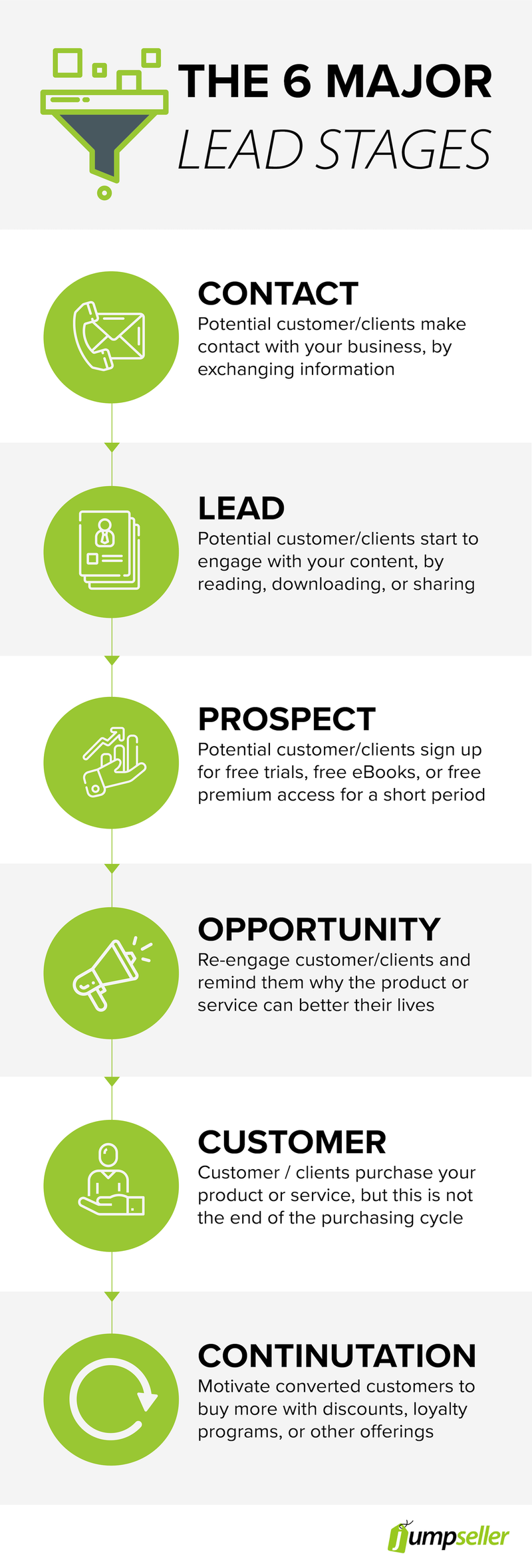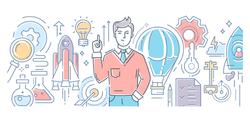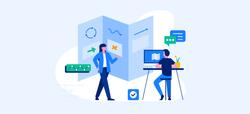Not all leads are created equal! Unfortunately, not all leads will result in a purchase. Over the years, those who study consumer habits have determined that most leads go through a set of phases, the final stage of which results in a purchase.
Some businesses may have specific names, numbers, and perspectives for each step in their lead stages. In fact, there are many specific lead stages for different industries. However, these six points cover the basics of each stage that many businesses and entrepreneurs agree on.

-
Contact
The stage where any potential customer or client makes contact with the business. This is the moment a possible client learns more about pricing and terms of service. Contact could be made in a variety of ways, but often is a result of a company’s marketing efforts.
However, contact isn’t complete unless some form of information sharing is done, such as signing up for a newsletter. After information is shared, your possible customer becomes a ‘contact.’
-
Lead
Even if someone has offered up their contact information, it doesn’t mean they are a lead. In most cases, if a user provides their contact information, that’s no indication that they will purchase your product or service.
For example, if a user signs up for your email newsletter, and then ignores your content or rarely engages, then that specific person will likely not be considered a lead. If, on the other hand, a recipient starts to engage with the content, either by reading, downloading, or sharing with friends, he/she can now be considered a lead.
-
Prospect
A lead is considered a prospect once the individual starts engaging with the content you are providing them. This could be a newsletter that he/she downloads, or even an app/service that they use.
At this point, business owners should begin to nurture their prospects by offering free trials, free ebooks, free courses, or free premium access for a short period.
Should the lead sign up for any one of these offerings, they are now considered a prospect! The chances of them completing a purchase have dramatically increased.
-
Opportunity
While becoming a prospect is a significant step above being a lead, merely engaging in a free trial does not mean the individuals will end up purchasing the product or service. In fact, many people who undergo a free trial do not end up making a purchase.
Nonetheless, the fact that they are engaging in your offering means they are thinking about your product, which is a major advantage. At this point in the lead stage development cycle, the potential buyer has to be re-engaged and be reminded of exactly why the product/service can improve their life.
-
Custom Stage
If the opportunity stage has been properly executed, the lead will usually end up buying the product or service being offered.
“For some businesses, this is the end of the route, and although they may continue to send emails or messages to the client, they don’t push them towards any further purchases,” writes Barb Williams, a technologist at Stateofwriting and Academized. However, many other businesses do, and this is called the custom stage, whereby the customer is further targeted to make more purchases.
The most common way to do this is by offering them a discount code on their next purchase or some other promotion that will motivate them to make further purchases.
-
Continuation Of Cycle
Most businesses sell a product that does not require repeat purchases, such as an item of clothing or a piece of software. There is nothing wrong with this, and most businesses operate this way.
David Shore, a content expert at Liahelp and OXessays, claims that “those who have purchased from a business in the past are likely to continue making purchases with them unless they had some sort of negative experience.” Encouraging your already-converted customers to purchase more of your goods and product, whether at a discount or another offering is a certain way to get attention.
For this reason, it is important to continually target existing customers with whatever new products or services the business may come out with, allowing past customers to complete the lead cycle again. Remember: your repeat customers are a precious commodity, and often are cheaper to market to than new customers.
Katherine Rundell is a marketer at Essay Writing Services. After several years developing marketing campaigns for several successful online businesses, she now spends much of her time writing about lead stages.





